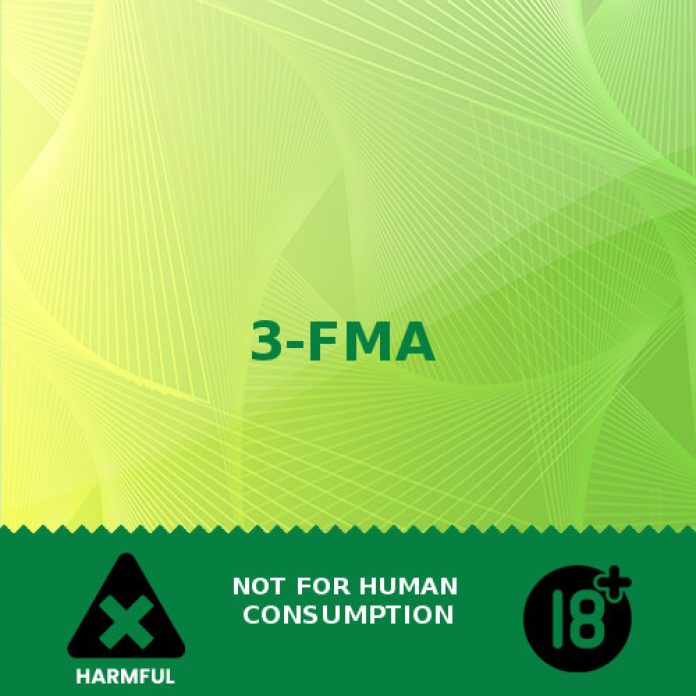In the ever-evolving landscape of psychoactive substances, 3-Fluoromethamphetamine, or 3-FMA, is an intriguing option for those seeking unique experiences. As a research chemical, it’s become known for its stimulating and empathogenic effects. This article will dive into the general information, history, dosage, administration, user reviews, and potential side effects of 3-FMA. Read on to learn more about this novel substance.
General Information on 3-FMA
We’ll start this research chemical review with general information about the substance. 3-FMA is a synthetic stimulant in the amphetamine class of compounds. The only difference between this drug and methamphetamine is the addition of a fluorine atom on the phenyl ring. This seemingly minor change results in a different pharmacological profile. In other words, 3-FMA shows a distinct set of effects when compared to its parent compound.
The compound usually comes in the form of a white or off-white powder, although other forms, like crystals or tablets, may also be encountered. The 3-FMA research chemical is mainly used for its stimulant and empathogenic properties, which result in increased energy, sociability, and euphoria. We’ll cover those in more detail below. However, as a research chemical, its safety profile remains relatively unknown. So, users should exercise caution when experimenting with this substance.
History of 3-FMA
The first fluorinated amphetamines (like 3-FMA) appeared on the research chemical market in the 2000s. These initial compounds, like 2-FA and 4-FA, became popular for their unique effects that combined the stimulation of traditional amphetamines with a milder comedown.
One of the new analog drugs of 2-FA is the 3-FMA research chemical, but it’s so new that few details exist about its exact history. Although it remains rather obscure, 3-FMA has amassed a dedicated following among researchers and psychonauts.
Despite its relatively recent emergence, 3-FMA has been the subject of several scientific studies to better understand its pharmacological profile and potential risks. Early research shows the compound may have a similar addiction potential to other amphetamines. Even so, further studies are needed to fully understand its safety profile.
In recent years, 3-FMA has gained a measure of notoriety following reports of its use in recreational settings. As is the story with other research chemicals, this led to more scrutiny from regulatory authorities. Users seeking legal drugs must be aware that the compound has been banned in several countries. However, it remains on the list of legal highs in other countries and remains a subject of interest.
Dosage and Administration
When experimenting with a research chemical like 3-FMA, understanding the appropriate dosage and administration methods but starting with a low dose is crucial for a safe and enjoyable experience. Factors like tolerance, desired effects, and administration method all play a role in determining the optimal dosage. Typical doses range from 5-50mg.
Oral Administration
The most common route of administration for 3-FMA is oral ingestion. Users normally consume doses in the range of 20-50 mg, with a lower dose providing a more manageable experience and higher doses resulting in more intense effects. It is advisable to start with a lower dose and adjust based on individual tolerance and desired effects.
Nasal Insufflation
Nasal insufflation, or “snorting,” is another popular method of taking the 3-FMA research chemical. This route of administration often results in a faster onset of effects and may provide a more intense experience. Keep in mind that it may cause nasal irritation and damage, so users should be careful.
Vaporization
Vaping 3-FMA may result in a rapid onset of effects. Also, it may be more efficient in terms of dosage. However, vaporization carries its own set of risks. Those include potential lung damage and the creation of toxic byproducts. As such, users should proceed with caution when considering this method.
Suppository
While less common, some users may choose to administer 3-FMA rectally as a suppository. This method can lead to a rapid onset of effects and increased bioavailability. However, it may also result in an increased risk of gastrointestinal issues and other complications.
Redosing
Some users may choose to redose with 3-FMA to maintain or extend the effects of the drug. However, redosing can bump up the risk of dangerous side effects and may contribute to a more severe comedown. Generally, it’s best to avoid redosing, particularly with high initial doses or when using the substance frequently.
User 3-FMA Reviews
As you explore this section of our 3-FMA review, remember that individual responses may vary, and some users may find the effects overwhelming. User reviews are based on completely subjective experiences, so you must take them lightly.
Onset of Effects
Users often report a relatively quick onset of effects following ingestion or insufflation, with noticeable sensations typically beginning within 30-60 minutes. Vaporization may result in an even faster onset, with effects being felt almost immediately.
Increased Energy & Sociability
User reviews highlight greater energy and sociability as one of the best aspects of the 3-FMA research chemical. Many users say they felt a surge of physical and mental energy that helped them engage in activities with more enthusiasm and motivation. A heightened sense of sociability frequently accompanies this energy boost. Users report increased confidence, empathy, and ease in conversing with others.
Focus
Another commonly reported effect of 3-FMA is an enhanced ability to focus on tasks and maintain concentration. Users describe feeling more alert, attentive, and capable of processing information, which can be particularly beneficial for those seeking a functional stimulant to aid in work or study. Some users have compared this aspect of the 3-FMA experience to traditional stimulants like Adderall or Ritalin, albeit with a milder and more manageable profile.
Euphoria
Many 3-FMA users report experiencing a sense of euphoria while under the influence of the substance. This euphoria is often described as a pleasant, uplifting sensation that can instill feelings of happiness, contentment, and emotional warmth. Higher doses and faster-acting methods like insufflation or vaporization potentially lead to more pronounced euphoric effects. While some users appreciate the euphoric aspect of 3-FMA for recreational purposes, others may find it beneficial for enhancing their overall mood and well-being during the experience.
Anticlimax (“Comedown”)
The comedown from 3-FMA is often reported as being relatively mild, particularly when compared to traditional amphetamines or other stimulants. Users may experience fatigue, difficulty sleeping, or a mild sense of depression, but these symptoms generally resolve within a day or two.
Potential Side Effects of 3-FMA
As a research chemical, the safety profile of 3-FMA remains relatively unknown. However, users have reported a range of potential side effects, including the following:
- Increased heart rate and blood pressure
- Anxiety and agitation
- Insomnia and difficulty sleeping
- Dehydration and dry mouth
- Loss of appetite
- Nausea and gastrointestinal issues
- Bruxism (jaw clenching)
- Sweating and elevated body temperature
- Vasoconstriction (narrowing of blood vessels)
When encountering negative side effects while using 3-FMA or any other psychoactive substance, it is essential to respond appropriately to ensure your safety and well-being. Don’t hesitate to call emergency services if needed.


